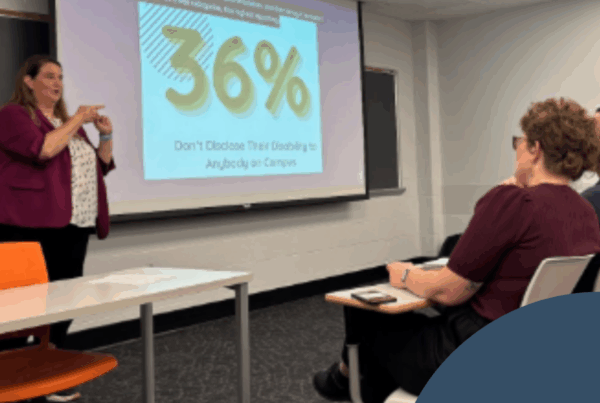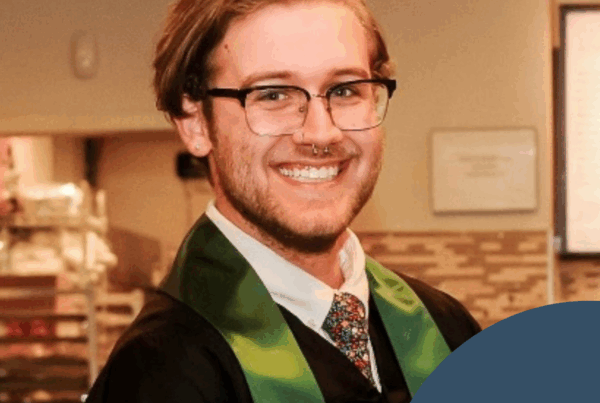Summary
Johnny Collett, Deputy Director of the Human Development Institute at the University of Kentucky, outlines how statewide collaboration is transforming disability inclusion. From legislative change to higher education and workforce development, his insights highlight Kentucky’s strategic approach to building more accessible systems.

Background
Our Executive Director, Stephanie W. Cawthon, PhD, recently interviewed Johnny Collett, MA, who serves as the Deputy Director at the University of Kentucky Human Development Institute, Kentucky’s university center on disability. His career path includes extensive experience in education and disability policy:
- Started as high school special education teacher
- Worked at the Kentucky Department of Education, eventually as the state Special Education Director
- Served as the Director of Special Education Outcomes at the Council of Chief State School Officers (CCSSO)
- Appointed as Assistant Secretary for the Office of Special Education and Rehabilitative Services at the U.S. Department of Education
- Currently at the University of Kentucky Human Development Institute for over five years
At the Human Development Institute, he supports the oversight of more than 60 externally funded projects across six priority areas: early childhood and education, leadership and self-advocacy, health, employment, assistive technology and universal design, and research and evaluation.
Kentucky is at a pivotal moment in its approach to disability inclusion, particularly in postsecondary education and workforce development. In this conversation, Collett shared several of Kentucky’s current innovative initiatives that may offer valuable lessons for other states seeking to improve outcomes for people with disabilities.
Employment First: From Policy to Law
In 2022, Kentucky transformed its Employment First initiative from an aspirational policy into state law. As Collett notes:
“In Kentucky, we’re an Employment First state… It’s been a law in Kentucky since 2022. We got to be a big part of that at the University Center on Disability.”
This legislative commitment elevates competitive, integrated employment as the presumed goal for all Kentuckians with disabilities. Unlike policy directives that can change with administrations, this legal foundation creates lasting accountability and signals the state’s long-term commitment to employment inclusion.
The law’s passage represents the culmination of years of advocacy and demonstrates how university centers of excellence can effectively partner with policymakers to create systemic change. The University of Kentucky Human Development Institute played a crucial role in this effort, exemplifying the potential impact of academic institutions when they actively engage in policy development.
Strategic Positioning in Workforce Development
What makes Kentucky’s approach particularly noteworthy is how disability employment has been positioned within broader economic development frameworks rather than solely as a social service concern:
“We’re in a different place in Kentucky than we’ve been in my 20-something years of knowing what’s going on here around seeing people with disabilities intentionally as in our workforce state plans as an underutilized population of talent.”
This strategic reframing shifts the conversation from obligation to opportunity, aligning disability employment with workforce development priorities that resonate with business leaders and economic policymakers. By focusing on talent development rather than compliance or charity, Kentucky has created new pathways for cross-sector collaboration.
Collett’s role as chair of the Education Attainment Committee on the Kentucky Workforce Innovation Board, keeps disability inclusion at the center of workforce strategy conversations rather than as a peripheral consideration. This structural positioning ensures that disability perspectives inform general workforce policies from the beginning rather than being addressed as an afterthought.
Comprehensive Transition Programs in Higher Education
Kentucky has developed an impressive network of higher education options for students with intellectual disabilities:
“There’s a program here at the University of Kentucky for students with intellectual disabilities. And we actually have six of those now in Kentucky. And we’re thrilled to have worked with the legislature… we have money in the state budget to help us kind of get some of those up and going and supported.”
What’s distinctive about Kentucky’s approach is the combination of:
- State budget allocation: Direct funding that provides sustainable resources rather than relying solely on grants or tuition
- Multi-institution implementation: Six programs across the state, creating increasingly more geographic accessibility
- Strategic growth: Careful scaling that prioritizes program quality and student success
- Systems change orientation: Recognition that these programs require fundamental institutional adaptation
This network of programs demonstrates Kentucky’s commitment to expanding post-secondary options beyond traditional academic pathways. By securing state funding, these initiatives have a stronger foundation for sustainability than programs that rely exclusively on federal grants or private funding.
Multi-Sector Coordination
Perhaps the most significant aspect of Kentucky’s approach is the intentional coordination across traditionally siloed systems:
“Because of some key strategic partnerships, we’re so thankful to have the University Center on Disability included…we’re in a different place in Kentucky than we’ve been in my 20-something years of knowing what’s going on here.”
These partnerships bridge traditional divides between:
- Higher education and K-12 systems
- Workforce development and disability services
- Government agencies and university research
- Economic development and social services
This level of coordination creates alignment across systems that typically operate independently, allowing for more seamless transitions and comprehensive approaches to complex challenges. The inclusion of the University Center on Disability in these partnerships ensures that evidence-based practices inform implementation and that initiatives are rigorously evaluated.
Evolving Employer Engagement
Kentucky is moving beyond simply declaring people with disabilities as an untapped talent pool to actively demonstrating how hiring them meets business needs:
“We can’t just say people with disabilities are a talent pool for you. Qualified individuals with disabilities are a talent pool for you, we’ve got to help employers see how that will meet their labor needs. And what their role is in training and coaching and supporting that individual to do that.”
This evolution from awareness to implementation addresses a common gap in disability employment initiatives. By focusing on employers’ specific labor needs and clarifying their role in training and supporting employees with disabilities, Kentucky is developing a more sustainable approach to inclusion that aligns with business priorities.
Legislative Engagement and Tracking
A distinctive element of Kentucky’s current approach is the systematic tracking of how general legislation affects people with disabilities:
“A lot of what I’m saying yes to right now is tracking state legislation that can have an impact on people with disabilities… Even with that, there have been more than a thousand bills filed in this session between the House and the Senate… even a much smaller number than that directly refers to people with disabilities, but actually about more than a couple dozen this year.”
This proactive monitoring recognizes that people with disabilities are affected by mainstream legislation, not just disability-specific bills. By analyzing the potential impact of general economic, education, healthcare, and social service legislation on people with disabilities, advocates can identify unintended consequences and opportunities for inclusion that might otherwise be overlooked.
Engagement with Rural Communities
Kentucky’s predominantly rural geography means its disability inclusion efforts must work in contexts often overlooked in urban-centric models. When discussing enrollment declines, Collett acknowledges that rural communities are on the front line for some of that. This attention to rural implementation distinguishes Kentucky’s approach from models developed primarily for metropolitan areas. By addressing the unique challenges of rural communities—including transportation barriers, limited service providers, and smaller employer bases—Kentucky’s initiatives offer valuable insights for other states with significant rural populations.
Moving from Rhetoric to Implementation
Perhaps most importantly, Kentucky appears to be at a pivotal transition point from establishing inclusive language to creating concrete implementation mechanisms. This progression from theoretical inclusion to practical implementation represents a crucial evolution that many disability initiatives never achieve. By acknowledging this next phase and actively working toward it, Kentucky demonstrates a maturity in its approach that avoids the common pattern of declaring success when policy language changes without corresponding implementation progress.
Conclusion
Kentucky’s current approach to disability inclusion stands out for its legal foundation, strategic positioning within economic development, state-funded higher education programs, multi-sector partnerships, evolving employer engagement, proactive legislative monitoring, rural focus, and implementation orientation. While these initiatives are still developing and their long-term outcomes remain to be seen, they represent a promising model that combines structural change, cross-system coordination, and practical implementation strategies.
As Collett concludes:
“I feel like we’re asking the right questions now in Kentucky. I feel like we’re asking that right first question. Now my sort of lean in is, okay, be the person in the room who asks the right second question. Who has the right third question.”
This commitment to progressively deeper questioning suggests Kentucky’s approach will continue to evolve, potentially offering valuable lessons for other states seeking to improve outcomes for people with disabilities across education, employment, and community life.


